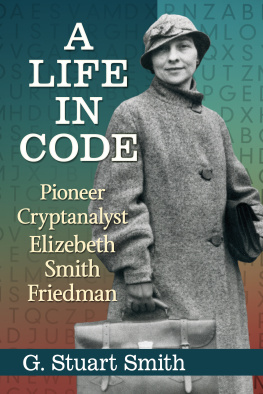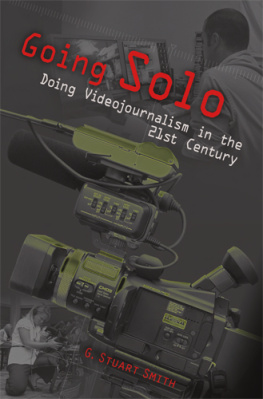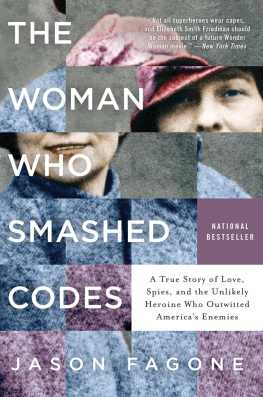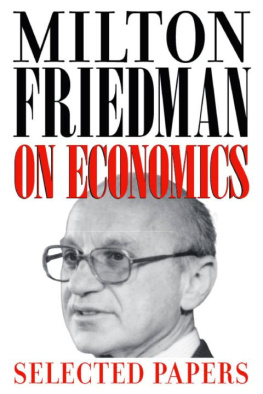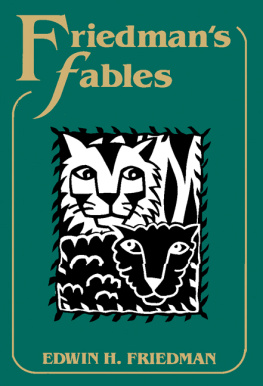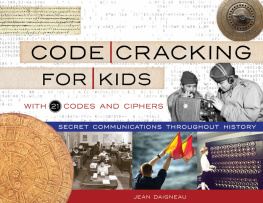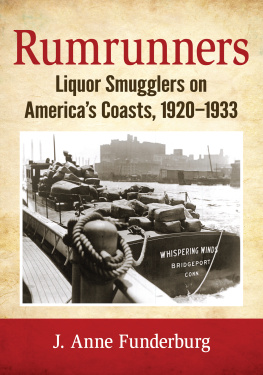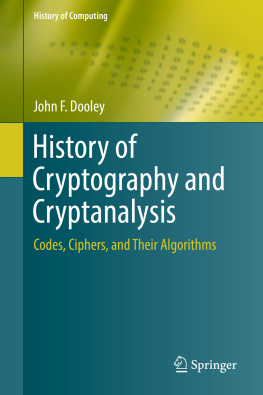
A Life in Code
Pioneer Cryptanalyst Elizebeth Smith Friedman
G. Stuart Smith

McFarland & Company, Inc., Publishers
Jefferson, North Carolina
LIBRARY OF CONGRESS CATALOGUING DATA ARE AVAILABLE
BRITISH LIBRARY CATALOGUING DATA ARE AVAILABLE
e-ISBN: 978-1-4766-2816-5
2017 G. Stuart Smith. All rights reserved
No part of this book may be reproduced or transmitted in any form or by any means, electronic or mechanical, including photocopying or recording, or by any information storage and retrieval system, without permission in writing from the publisher.
Front cover image of Elizebeth Smith Friedman National Security Agency
McFarland & Company, Inc., Publishers
Box 611, Jefferson, North Carolina 28640
www.mcfarlandpub.com
For Chris, Vanessa and Eric
Preface
When I was a teenager my parents handed me a well-worn copy of a 1937 edition of Readers Digest. They said it was mine to keep and preserve. In it was an article about my great aunt, Elizebeth Smith Friedman, titled Key Woman of the T-Men. I read the article with the semi-interest a 14-year-old boy has about a relative he had never met, then put it aside to pursue other interests. About three decades later, I got a call out of the blue. The voice on the phone said, You dont know me, but Im your second cousin. John Friedman, the son of William and Elizebeth, had moved to Sanibel Island, Florida, near where I was working as a TV reporter in Fort Myers.
John invited me for lunch at his home and proceeded to tell me about his mother and father. At first I was most interested in William Friedman, who broke the Japanese cipher Purple before World War II. John told me that upon hearing the radio report about the Pearl Harbor attack, his father said, But they knew, they knew, they knew. With a deep interest in World War II history, and a reporters sense of a good controversy, I never forgot that.
While always working on other projects, I kept the code couple in the back of my mind, waiting for an opportune time to research them. I was working on a documentary in 2006 and while returning home decided to stop by the National Cryptologic Museum just outside the National Security Agency headquarters in Maryland. I was surprised to discover that William and Elizebeth Friedman rated their own display. He was billed as the Dean of American Cryptology, but both were enshrined in the Cryptologic Hall of Honor. When I finished the documentary, I decided to pursue a project about the code couple.
William already had a book about his accomplishments; I also discovered while doing more research that everything that seemingly could be investigated about the controversy over what the government knew about Japanese intentions before Pearl Harbor had already been written by historians, military theorists and conspiracy junkies.
Elizebeth, however, was a totally different matter. As one of the most publicized federal agents in Prohibition and with information about her World War II work just being declassified, Elizebeth also seems highly deserving of a book. Yet one cannot talk about Elizebeth without also including William as well. They truly were a code couple. In the middle of their careers, they labored separately, but at the start, and to a degree at the end, they were major collaborators.
Getting information for the book has sometimes been a challengeespecially specifics on Elizebeths World War II work. I have made numerous trips to the National Archives in College Park, Maryland, Washington, D.C., and New York City; I searched the British National Archives online and in person at Kew as well as the Canadian archives in Ottawa; I have filed a dozen Freedom of Information requests with the NSA and FBI; I have reviewed the Friedman papers at the George C. Marshall Library twice. Elizebeth wrote memoirs of her Riverbank and Prohibition years, but just a few lines about her secret work between 1940 to 1945. I have had to rely on information about her Coast Guard unit that was declassified in 2008 to extrapolate from that as to what Elizebeth achieved during the war.
I would like to thank several people for their help in the process of researching and writing this book. First, I need to thank the late John Friedman. Without his call many years ago, I might not have been tipped off to the importance of his parents accomplishments. I called on John a few times before his death in 2010 for more information. After he died, I also tracked down his sister, Barbara Atchison. I interviewed her in person and on the phone several times before her death in 2014. Her son, Chris, also has been a great help, offering information and encouragementnot to mention a place to stay while interviewing his mother. It also has been a pleasure getting to know these members of my extended family.
Others who have been of great assistance include Paul Barron and Jeffrey Kozak at the George C. Marshall Research Library at Virginia Military Institute, where the Friedmans donated a trove of cryptographic literature and their own papers. Commander Michael Bennett of the Coast Guard has also been a giant help. He began his research of the World War II Guardian Spies of the Coast Guard well before I decided to dip my toe into the water. He is the one who first gave me a clue about Elizebeth Friedmans important role in breaking German spy codes during the war. The historian at the Bureau of Alcohol, Tobacco, Firearms, and Explosives, Barbara Osteika, has been of great assistance as well. There are many at the NSAs Center for Cryptologic History who have lent advice and encouragement including Betsy Smoot, Rene Stein and Dr. David Hatch. Thanks also go to Dr. David Sherman of the NSA, who I understand led the charge to declassify and release the Friedman papers in 2015. Colonel Rose Mary Sheldon, Gail Heiser, Chris Christensen, Bob Hanyok, David Kahn, Sandra Jacobs and Deeg Mitchell also lent advice and support. Steve Thomas, one of my distant cousins, also supplied some background on Elizebeths family ties. Many at the National Archives in both College Park and Washington have been a great help when I visited. Unfortunately, I do not know all of their names, so I hesitate to name only a few.
Writing this book certainly would not have been possible without Elizebeth Smith Friedmans help. Though I never met my great aunt, I feel I have come to know her. Fortunately, she left pages and pages of memoirs that chronicle her romance with William, raising their two children, and the intricate details of many of the high profile cases that she helped solve. She also wrote of the troubled times in Prohibition, the Great Depression and the period leading up to World War II. Her papers have become my most valuable resource.
Thanks to Hofstra University for defraying some of my research costs by issuing me several faculty research grants.
Finally, my wonderful companion, Pam Deitrich, has assisted me in the research and was the first to critique my writing.
I set out to write about Elizebeth Smith Friedman, not a code breaking manual. In doing that I also had to delve into the world of cryptanalysis and cryptographyfields in which I have absolutely no expertise. I have used examples of many of the codes and ciphers that Elizebeth solved, but attempted to simplify them so that almost anyone could understand the cryptanalytic process. If there are mistakesor oversimplifications for those who desire more cryptographic detailthe fault is solely mine, and I apologize.
Next page
